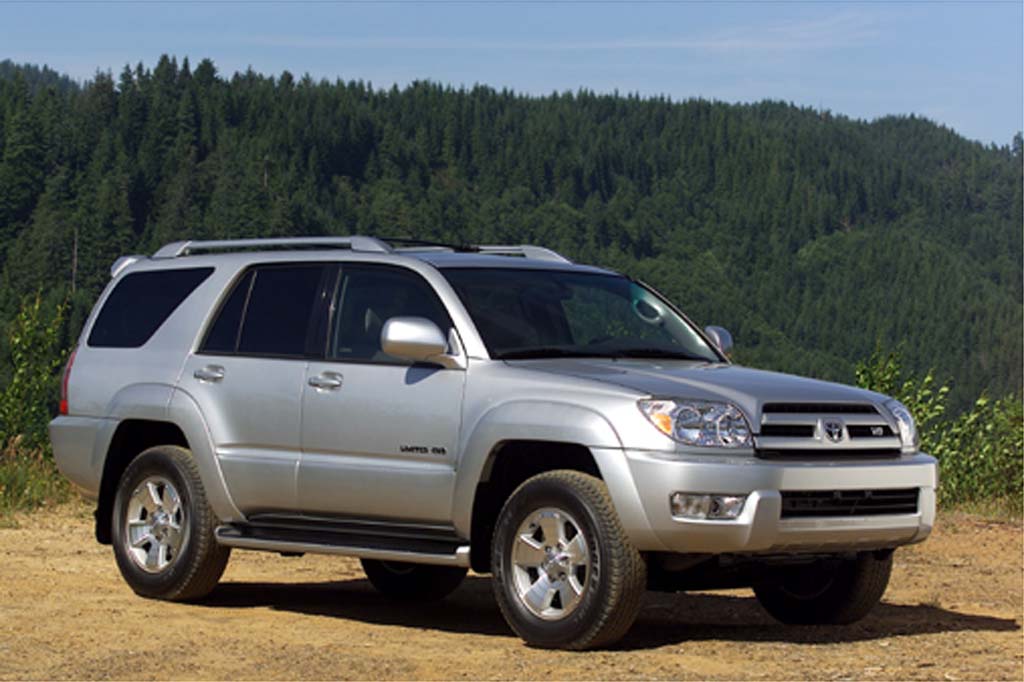| Midsize SUV; Built in Japan |
|
|
| Good condition price range: $7,700 – $26,500* |

2003 Toyota 4Runner

2004 Toyota 4Runner

2005 Toyota 4Runner

Toyota 4Runner interior
| Pros: |
|
| Cons: |
|
Some competitors offer a smoother ride and sharper on-road handling, but no comparably priced truck-type SUV beats the 4Runner for powertrain polish, off-road ability, and overall refinement. Few match its array of standard safety features and traction-enhancers. Toyota’s reputation for reliability is another plus, but high resale values keep secondhand prices on the hefty side.
Overview
For 2003, Toyota redesigned its truck-based midsize sport-utility vehicle for the first time in seven years, giving it larger dimensions, new features, and its first available V8 engine. The 4Runner gained 4.5 inches in wheelbase and overall length, more than 3 inches in width, and 2 inches in height. Weight also escalated, by some 200 pounds.
Despite the size increase, head and leg room remained about the same, though shoulder space and cargo volume grew slightly. Three models were offered: SR5, Sport, and Limited. Each seated five on front buckets (with height-adjustable driver’s seat) and a split folding rear bench. No third-row seat was offered.
A power tailgate window was again standard. A V6 engine also remained standard, but it was now a 245-horsepower 4.0-liter, instead of the previous 183-hp 3.4-liter. The optional V8 was the 4.7-liter, also used in Toyota’s Sequoia full-size SUV, here tuned to produce 235 horsepower. While the V6 produced more horsepower, the V8 made more torque: 320 pound-feet, versus 283 for the V6. Both engines used automatic transmissions: a four-speed for the V6 and a new five-speed for the V8.
The 4Runner came with rear-wheel drive or four-wheel drive. The V6’s 4WD system could be left engaged on dry pavement, and V8 models got all-wheel drive. Both 4WD systems included low-range gearing.
Traction control and an antiskid system continued as standard. Antilock brakes also remained standard, but with four-wheel discs instead of the prior disc/drum setup. Standard 16-inch wheels replaced 15s, made of steel rather than alloy. Sport and Limited models rode on 17-inch alloys.
For the first time, the 4Runner was available with side airbags: a combination of front torso and head-protecting front/rear curtain side airbags. Other new options included a navigation system, rear-seat audio with wireless headphones, and a rear air suspension. Maximum towing capacity was 5000 pounds.
With the 4Runner, Toyota competed against the Acura MDX, Ford Explorer, and Toyota’s own Highlander. The 4Runner shared its platform with the new GX 470 from Toyota’s Lexus division.
Yearly Updates
| 2004 4Runner Toyota’s truck-based SUV gained an optional third-row seat for 2004, along with an available rearview monitor. The already-available navigation system could now be equipped with a TV camera that displayed a rear view on the dashboard screen when Reverse gear was selected. The new two-passenger third-row seat option joined an available rear-seat audio system with wireless headphones. Hill Descent Control, standard on 4WD/AWD models, was designed to maintain a slow, steady speed down steep slopes. A similar Hill Ascent Control was also standard. The available curtain side airbags were now designed to deploy when sensors detected an impending rollover. A firmer suspension was standard on Sport models and optional for the Limited. A load-leveling rear air-spring suspension was available for V8 Limiteds. |
| 2005 4Runner Toyota’s V8 engine gained 35 horsepower in 2005, now rated at 270. A five-speed automatic transmission replaced the four-speed unit in V6 models. A sunroof was now optional on all models, no longer standard on the Limited. |
| 2006 4Runner There were no changes for the 2006 4Runner. |
| 2007 4Runner 4Runner carried over unchanged. |
| 2008 4Runner The 2008 Toyota 4Runner was largely unchanged. |
| 2009 4Runner Once again, the 4Runner saw few changes. |
